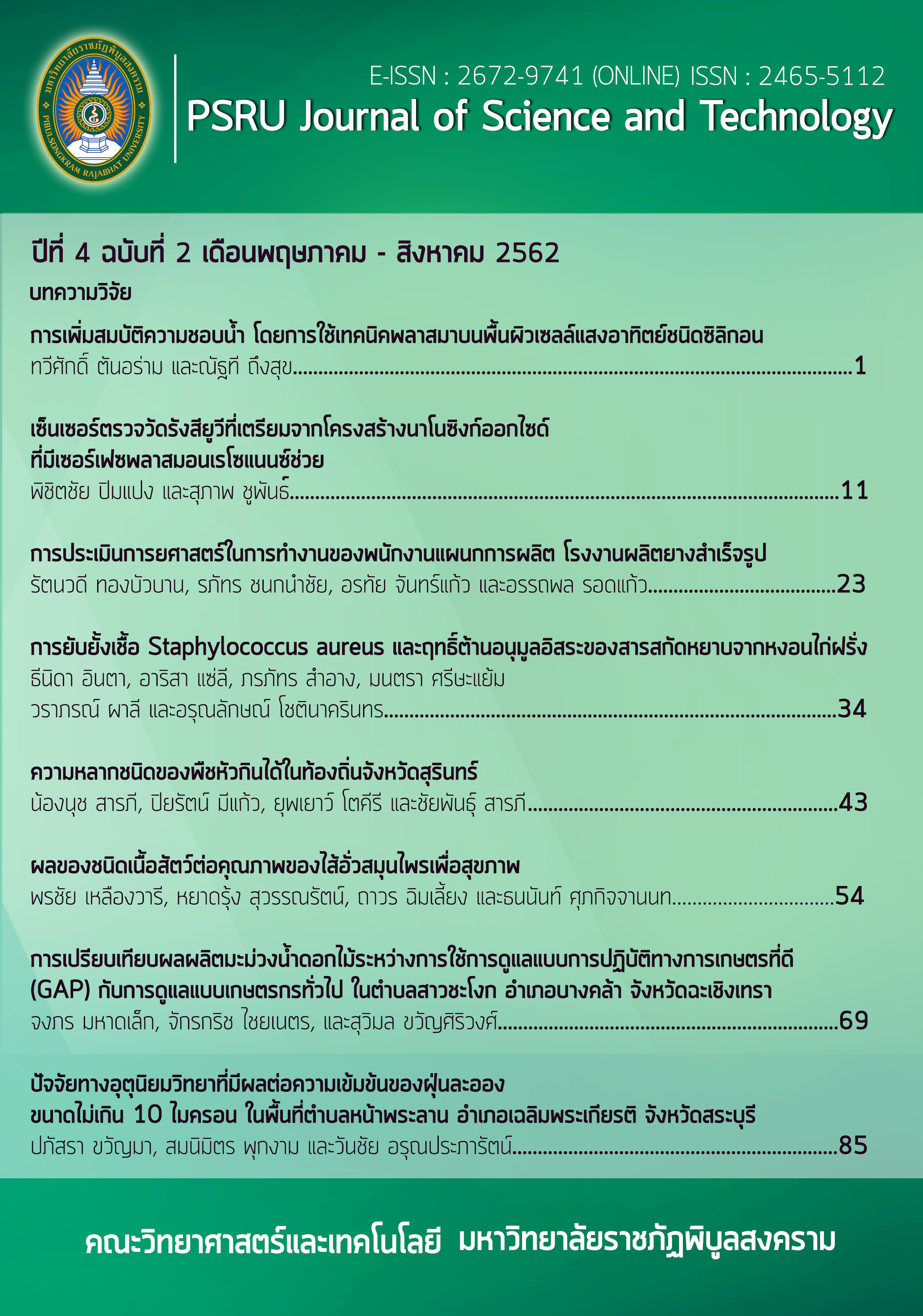UV SENSOR BASED ON ZINC OXIDE NANOSTRUCTURES ASSISTED BY SURFACE PLAMON RESONANCE
Keywords:
UV sensor, ZnO nanostructures, gold nanoparticles, surface plasmon resonanceAbstract
In this work, ultraviolet (UV) sensing properties of ZnO nanostructures were investigated and compared to ZnO nanostructures embedded with gold nanoparticles. Firstly, zinc films were thermally oxidized to form ZnO nanostructures at 700°C for 10 hours. To form gold nanoparticles embedded ZnO nanostructures, gold nanoparticles were embedded onto the surface of ZnO nanostructures by photoreduction of HAuCl4. ZnO nanostructures and gold nanoparticles embedded ZnO nanostructures were then fabricated as UV sensor with active area of 1 mm2. Au electrodes were patterned on the sensing layer by screen printing of electrical conductive gold paste. Finally, UV sensing properties were investigated of UV illumination (365 nm) and a 10 V bias. The result of UV sensing investigation showed that embedding gold nanoparticles onto ZnO nanostructures and green light illumination (532 nm) caused to improve the sensor repeatability. In addition, the sensor recovery of gold nanoparticles embedded ZnO nanostructures and green light illumination seems to have lower recovery time than other cases due to the faster rate of charge transfer from embedded gold nanoparticles to ZnO nanostructures. Accordingly, the improvement of sensor repeatability and recovery time can be explained in terms of a charge transfer process by considering the surface plasmon resonance effect of gold.
References
พิชิตชัย ปิมแปง,วีระศักดิ์ ทองอ่อน และสุภาพ ชูพันธ์. (2018). การปรับปรุงสมบัติการตรวจวัดอะเซทิลีนของเส้นลวดนาโนซิงก์ออกไซด์ด้วยการเติมอนุภาคนาโนทองคำ. PSRU Journal of Science and Technology. 3(2), 1-12.
Beani, J. C. (2014). Ultraviolet A-induced DNA damage; role in skin cancer. Bulletin de l'Académie nationale de medicine, 198(2), 273-295.
Cheng, C. W., Sie, E. J., Liu, B., Huan, C. H. A., Sum, T. C., Sun, H. D. and Fan, H. J. (2010). Surface plasmon enhanced band edge luminescence of ZnOnanorodsby capping Au nanoparticles. Applied Physics Letter, 96, 071107. doi.org/10.1063/1.3323091.
Do, T. A. T., Ho, T. G., Bui, T. H., Pham, Q. N., Giang, H. T., Do, T. T., Nguyen, D. V. and Tran, D. L. (2018). Surface-plasmon-enhanced ultraviolet emission of Au-decorated ZnO structures for gas sensing and photocatalytic devices. Beilstein Journal of Nanotechnology, 9, 771–779.
Gao, W. and Li, Z. (2004). ZnO thin films produced by magnetron sputtering. Ceramics International, 30, 1155-1159.
Guidelli, E. J., Baffa, O. and Clarke, D. R. (2015). Enhanced UV emission from silver/ZnOand gold/ZnOcore-shell nanoparticles; photoluminescence, radioluminescence and optically stimulated luminescence. Scientific Reports, 5, 14004. doi: 10.1038/srep14004.
Jandow, N. N., Abu Hassan, H., Yam, F. K. and Ibrahim, K. (2012). ZnO Metal-Semiconductor-Metal UV Photodetectors on PPC Plastic with Various Metal Contacts. Sanka Gateva (Ed.). Photodetectors (pp. 1-32). London: IntechOpen.
Jiang, R., Li, B., Fang, C. and Wang, J. (2014). Metal/Semiconductor Hybrid Nanostructures for Plasmon‐Enhanced Applications. Advanced Materials, 26, 5274–5309.
Kinney, J. P., Long, C. S. and Geller, A. C. (2000). The Ultraviolet Index; A Useful Tool. Dermatology Online Journal, 6(1). จาก https;//escholarship.org/uc/item/5925w4hq. เข้าถึงเมื่อ 8 ตุลาคม 2561.
Lin, H. Y., Cheng, C. L., Chou, Y. Y., Huang, L. L., Chen, Y. F. and Tsen, K. T. (2006). Enhancement of band gap emission stimulated by defect loss. Optics Express, 14(6), 2372-2379.
Li, R., Zhang, F., Wang, D., Yang, J., Li, M., Zhu, J., Zhou, X., Han, H. and Li, C. (2013). Spatial separation of photogenerated electrons and holes among {010} and {110} crystal facets of BiVO4. Nature Communications, 4, 1432. doi:10.1038/ncomms2401.
Matsui, M. S. (1991). Longwave ultraviolet radiation and promotion of skin cancer. Cancer Cells. 3(1), 8-12.
Pimpang, P., Zoolfakar, A. S., Wongratanaphisan, D., Gardchareon, A., Nguyen, E. P., Zhuiykov, S., Choopun, S. and
Kalantar-zadeh, K. (2013). Atomic force microscopy adhesion mapping; Revealing assembly process in inorganic systems. Journal of Physical Chemistry C, 117, 19984-19990.
Rünger, T. M. (1994). Role of UVA in the pathogenesis of melanoma and non-melanoma skin cancer. A short review. Photodermatol Photoimmunol Photomed, 15(6), 212-216.
Schmitz, S., Garbe, C., Tebbe, B. and Orfanos, C. E. (1994). Long-wave ultraviolet radiation (UVA) and skin cancer. Hautarzt, 45(8), 517-525.
Young, S., Ji, L., Chang, S. and Su, Y. (2006). ZnO metal–semiconductor–metal ultraviolet sensors with various contact electrodes. Journal of Crystal Growth, 293, 43-47.
Yu, S., Lee, S.Y., Yeo, J., Han, J. W. and Yi, J. (2014). Kinetic and Mechanistic Insights into the All-Solid-State Z-Schematic System. Journal of Physical Chemistry C, 118, 29583–29590.
Downloads
Published
How to Cite
Issue
Section
License
กองบรรณาธิการขอสงวนสิทธิ์ในการปรับปรุงแก้ไขตัวอักษรและคำสะกดต่างๆ ที่ไม่ถูกต้อง และต้นฉบับที่ได้รับการตีพิมพ์ในวารสาร PSRU Journal of Science and Technology ถือเป็นกรรมสิทธิ์ของคณะวิทยาศาสตร์และเทคโนโลยี มหาวิทยาลัยราชภัฏพิบูลสงคราม และ
ผลการพิจารณาคัดเลือกบทความตีพิมพ์ในวารสารให้ถือมติของกองบรรณาธิการเป็นที่สิ้นสุด







